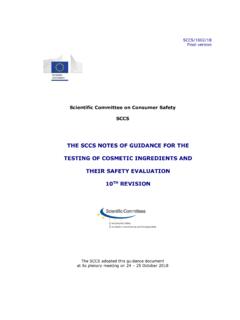Transcription of Developing Your Search Question using PICO/PIO/PEO
1 Developing Your Search Question using PICO/PIO/PEO For Evidence Based Practice (EBP) searches, you will often be expected to break down your Question into its key concepts using an EBP formula such as pico , PIO or PEO. pico : Population/Problem/Patient; Intervention/Issue; Comparison; Outcome PIO: Population/Problem/Patient; Intervention/Issue; Outcome PEO: Population/Problem/Patient, Exposure, Outcome Example pico /PIO Questions and Structures Intervention/therapy: In _____ (P), what is the effect of _____ (I) on _____ (O) compared with _____ (C)? In _____ (P), what is the effect of _____ (I) on _____ (O)? In _____ (P), how does _____ (I) compared to _____ (C) affect _____ (O)? Example: In obese females (P), how does weight loss (I) compared to daily administration of ACE inhibitors (C) affect blood pressure (O)?
2 Etiology: Are _____ (P) who have _____ (I) at (increased/decreased) risk for/of _____ (O) compared with _____ (P) with/without _____ (C)? Are _____ (P) who have _____ (I) compared with those without _____ (C) at (increased/decreased) risk for/of_____ (O)? Example: Are adopted children (P) who have parents with elevated BMI (I) compared with those parents with normal BMI (C) at increased risk for obesity (O)? Diagnosis or diagnostic test: Are (is) _____ (I) more accurate in diagnosing (O) _____ (P) compared with _____ (C)? In _____ (P) are/is _____ (I) compared with _____ (C) more accurate in diagnosis (O)? Example: In patients at high risk for gallbladder dysfunction (P) is a HIDA scan (I) compared with an ultrasound (C) more accurate in diagnosis (O)?
3 Prevention: For _____ (P) does the use of _____ (I) reduce the future risk of _____ (O) compared with _____ (C)? For _____ (P) does the use of _____ (I) compared with _____ (C) reduce the future risk of _____ (O)? Example: For obese children (P) does the use of community recreation activities (I) compared to educational programs (C) on lifestyle changes reduce the risk of diabetes mellitus (O)? Prognosis/Predictions: Does _____ (I) influence _____ (O) in patients who have _____ (P)? In _____ (P) how does _____ (I) compared with_____ (C) influence or predict _____ (O)? Example: In adults with prostate cancer (P) how does surgery (I) compared with not undergoing surgery (C) influence lifespan and quality of life (O)?
4 Meaning: How do _____ (P) diagnosed with _____ (I) perceive _____ (O)? How do _____ (P) with _____ (I) perceive _____ (O)? Example: How do elderly patients in orthopaedic rehabilitation (P) who have been separated from significant pets (I) perceive their motivation to progress (O)? (Adapted from Melnyk and Fineout-Overholt, 2019) EBSCO (2019) have also produced a handout with some example pico questions which you can view here. pico database Search strategy example In patients at high risk for gallbladder dysfunction (P) is a HIDA scan (I) compared with an ultrasound (C) more accurate in diagnosis (O)? This pico statement contains four key concepts (the P, the I, the C and the O). The database Search strategy could look like: Search 1 (P): gallbladder dysfunction OR gallbladder disease OR gallbladder inflammation Search 2 (I): HIDA scan OR Hepatobiliary Iminodiacetic Acid scan OR cholescintigraphy OR hepatobiliary scintigraphy Search 3 (C) ultrasound OR sonogram OR sonograph Search 4 (O): diagnosis OR assessment OR screening Search 5: Search 1 AND Search 2 AND Search 3 AND Search 4 However, as you are comparing 2 different interventions, you should also consider doing separate searches for each intervention: one Search just for the HIDA scan terms Search 1 AND Search 2 AND Search 4 and one Search just for the ultrasound terms Search 1 AND Search 3 AND Search 4.
5 PIO database Search strategy example For obese children (P) do educational programs on lifestyle changes (I) reduce the risk of diabetes mellitus (O)? This PIO statement contains three key concepts (the P, the I and the O) but in this case the P and the I both have two parts. The database Search strategy could look like: Search 1 (P): obese OR overweight OR high BMI OR high Body Mass Index Search 2 (P): children OR young people OR youth Search 3 (I): education OR teaching Search 4 (I): lifestyle OR healthy eating OR exercise OR healthy living Search 5 (O): diabetes mellitus OR type 2 diabetes OR non-insulin dependent diabetes Search 5: Search 1 AND Search 2 AND Search 3 AND Search 4 AND Search 5 PEO Questions for qualitative research P: Who are the affected population - patients, family, practitioners or community?
6 What are their symptoms, condition, health status, age, gender, ethnicity? What is the setting acute care, community, mental health? E: Is the population exposed to a condition or illness ( dementia), to a risk factor ( smoking), to screening, to rehabilitation or to a service? O: What are the outcomes or themes? Consider the experiences, attitudes, feelings, changes in condition, mobility, response to treatment, quality of life or daily living. (Adapted from Bettany-Saltikov, 2016) PEO database Search strategy example What are the attitudes (O) of health professionals (P) towards caring for older patients with dementia (E) in an acute setting (P)? The PEO statement contains three key concepts (the P, the E and the O), but in this case the P and the E have two parts.
7 The database Search strategy could look like: Search 1 (P): Acute care OR acute setting OR hospital Search 2 (P): Nurse OR professional OR practitioner OR staff OR personnel Search 3 (E): older patient OR older person OR elderly OR geriatric Search 4 (E): Dementia OR Alzheimer Search 5 (O): Attitude OR opinion OR perception OR perspective OR belief Search 6: Search 1 AND Search 2 AND Search 3 AND Search 4 AND Search 5 (Adapted from University of Suffolk, no date) Top Tips! 1. Asking a searchable, answerable Question is a basic step in the EBP process (Fineout-Overholt and Johnston, 2005, ). In order to identify a suitable Question it would be beneficial to carry out a scoping Search for your area of interest first (based on the clinical situation you have identified) to ensure that there is published research available on your topic.
8 2. If you struggle to identify additional keywords for your Search terms you could: a. use a textbook to get an overview of your subject b. use a medical dictionary or encyclopaedia for a definition of your key concept c. check references you already have - what terms have they used to describe your topic? d. look online The University of Suffolk have produced a helpful health thesaurus (Holmes, no date) 3. The intervention or exposure is usually the easiest to define. If you get too many results you could consider redoing this Search string as a title or abstract Search . This will limit and focus the Search results. Alternatively if you are not getting enough results, try searching just for the intervention or exposure.
9 4. You may not need to Search for each part of the pico , PIO or PEO formula. If you are not getting enough results, consider leaving one part out of your Search . For example, outcomes can be difficult to define ( improving patient care) and may make your results too specific. 5. If you are comparing an intervention to standard care or no intervention you may need to do more than one Search . One which includes the intervention and one which does not. Simply searching for terms like standard care or no intervention may not be effective on their own. 6. It does not matter if your database Search does not follow the same order as your pico , PIO or PEO statements. 7. Some terms may require more than one Search string if your population is dementia patients in an acute setting.
10 You will need to Search for dementia and acute setting separately, before combing them together : Search 1: Acute care OR acute setting OR hospital Search 2: Dementia OR Alzheimer OR cognitive impairment OR memory loss Search 3: Search 1 AND Search 2 References: Bettany-Saltikov, J. and McSherry, R. (2016) How to do a systematic literature review in nursing: a step-by-step guide. 2nd edn. London: Open University Press. EBSCO (2019) What is the pico Process? Available at: (Accessed: 15 November 2019). Fineout-Overholt, E. and Johnston, L. (2005) Teaching EBP: asking searchable, answerable clinical questions , Worldviews On Evidence-Based Nursing, 2(3), pp. 157-160. Holmes, K. (no date) Thesaurus for Nursing & Health Sciences.



